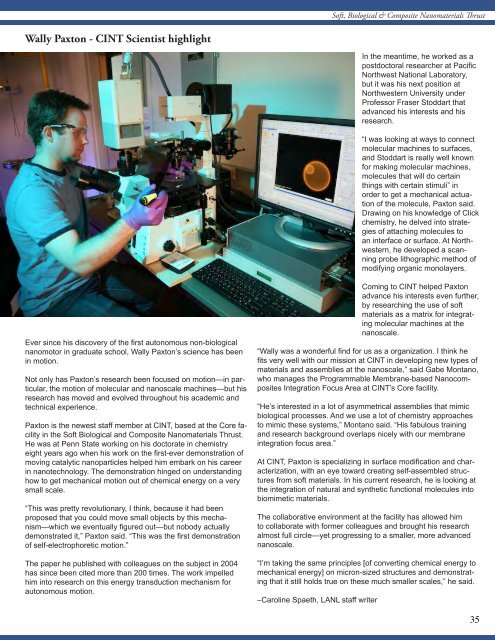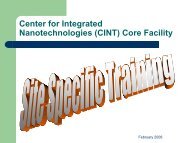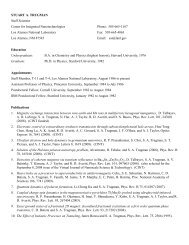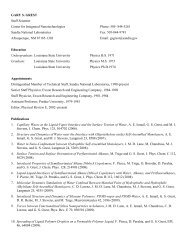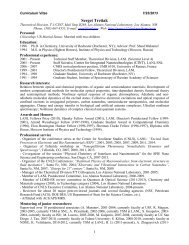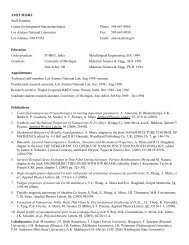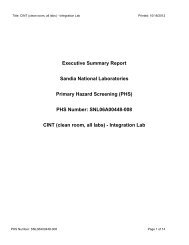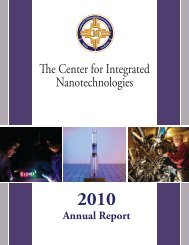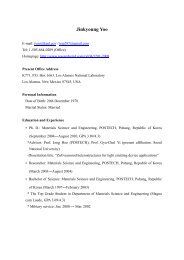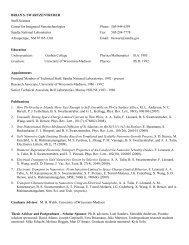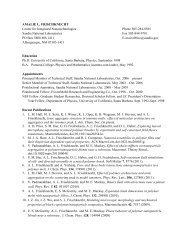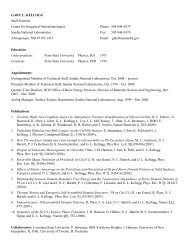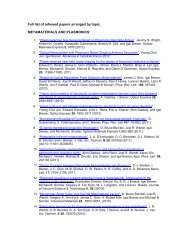2011 Annual Report - Center for Integrated Nanotechnologies - Los ...
2011 Annual Report - Center for Integrated Nanotechnologies - Los ...
2011 Annual Report - Center for Integrated Nanotechnologies - Los ...
Create successful ePaper yourself
Turn your PDF publications into a flip-book with our unique Google optimized e-Paper software.
Soft, Biological & Composite Nanomaterials Thrust<br />
Wally Paxton - CINT Scientist highlight<br />
In the meantime, he worked as a<br />
postdoctoral researcher at Pacific<br />
Northwest National Laboratory,<br />
but it was his next position at<br />
Northwestern University under<br />
Professor Fraser Stoddart that<br />
advanced his interests and his<br />
research.<br />
“I was looking at ways to connect<br />
molecular machines to surfaces,<br />
and Stoddart is really well known<br />
<strong>for</strong> making molecular machines,<br />
molecules that will do certain<br />
things with certain stimuli” in<br />
order to get a mechanical actuation<br />
of the molecule, Paxton said.<br />
Drawing on his knowledge of Click<br />
chemistry, he delved into strategies<br />
of attaching molecules to<br />
an interface or surface. At Northwestern,<br />
he developed a scanning<br />
probe lithographic method of<br />
modifying organic monolayers.<br />
Ever since his discovery of the first autonomous non-biological<br />
nanomotor in graduate school, Wally Paxton’s science has been<br />
in motion.<br />
Not only has Paxton’s research been focused on motion—in particular,<br />
the motion of molecular and nanoscale machines—but his<br />
research has moved and evolved throughout his academic and<br />
technical experience.<br />
Paxton is the newest staff member at CINT, based at the Core facility<br />
in the Soft Biological and Composite Nanomaterials Thrust.<br />
He was at Penn State working on his doctorate in chemistry<br />
eight years ago when his work on the first-ever demonstration of<br />
moving catalytic nanoparticles helped him embark on his career<br />
in nanotechnology. The demonstration hinged on understanding<br />
how to get mechanical motion out of chemical energy on a very<br />
small scale.<br />
“This was pretty revolutionary, I think, because it had been<br />
proposed that you could move small objects by this mechanism—which<br />
we eventually figured out—but nobody actually<br />
demonstrated it,” Paxton said. “This was the first demonstration<br />
of self-electrophoretic motion.”<br />
The paper he published with colleagues on the subject in 2004<br />
has since been cited more than 200 times. The work impelled<br />
him into research on this energy transduction mechanism <strong>for</strong><br />
autonomous motion.<br />
Coming to CINT helped Paxton<br />
advance his interests even further,<br />
by researching the use of soft<br />
materials as a matrix <strong>for</strong> integrating<br />
molecular machines at the<br />
nanoscale.<br />
“Wally was a wonderful find <strong>for</strong> us as a organization. I think he<br />
fits very well with our mission at CINT in developing new types of<br />
materials and assemblies at the nanoscale,” said Gabe Montano,<br />
who manages the Programmable Membrane-based Nanocomposites<br />
Integration Focus Area at CINT’s Core facility.<br />
“He’s interested in a lot of asymmetrical assemblies that mimic<br />
biological processes. And we use a lot of chemistry approaches<br />
to mimic these systems,” Montano said. “His fabulous training<br />
and research background overlaps nicely with our membrane<br />
integration focus area.”<br />
At CINT, Paxton is specializing in surface modification and characterization,<br />
with an eye toward creating self-assembled structures<br />
from soft materials. In his current research, he is looking at<br />
the integration of natural and synthetic functional molecules into<br />
biomimetic materials.<br />
The collaborative environment at the facility has allowed him<br />
to collaborate with <strong>for</strong>mer colleagues and brought his research<br />
almost full circle—yet progressing to a smaller, more advanced<br />
nanoscale.<br />
“I’m taking the same principles [of converting chemical energy to<br />
mechanical energy] on micron-sized structures and demonstrating<br />
that it still holds true on these much smaller scales,” he said.<br />
–Caroline Spaeth, LANL staff writer<br />
35


